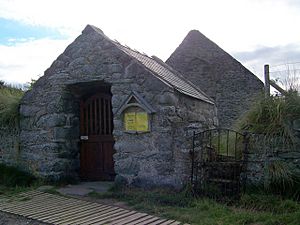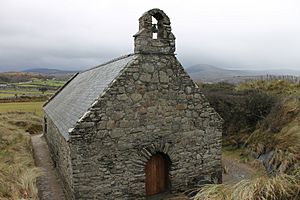St Tanwg's Church, Llandanwg facts for kids
Quick facts for kids St Tanwgs, Llandanwg |
|
|---|---|
| The Church in the Sand | |

St Tanwg's church with the lych gate in the foreground
|
|
| 52°49′57″N 4°07′34″W / 52.832615°N 4.125985°W | |
| Location | Llandanwg, Gwynedd |
| Country | Wales |
| Denomination | Anglican |
| History | |
| Dedication | St Tanwg |
| Architecture | |
| Functional status | active |
| Administration | |
| Parish | Bro Ardudwy |
| Deanery | Meirionydd Synod |
| Archdeaconry | Meirionnydd |
| Diocese | Bangor |
| Province | Church in Wales |
St Tanwg's Church, Llandanwg is a very old church in the village of Llandanwg, Gwynedd, Wales. It's also known as "the church in the sand" because of where it's built. This special church is dedicated to St Tanwg and is a Grade I listed building, which means it's super important and protected.
Contents
Where is St Tanwg's Church?
This unique church sits right in the middle of sand dunes. It's only about 20 meters (about 65 feet) from the sea, near the St George's Channel. Because it's so close to the water, it's often called "the church in the sand." You can find it at the southern end of Llandanwg village. The River Artro also flows into the sea nearby.
A Long History of St Tanwg's Church
How Old is the Church?
The church building you see today is from the medieval period. Parts of it, especially the western end, might be as old as the 13th century (the 1200s). But the site itself is much, much older! Stones found here have carvings from the 6th century (the 500s). This suggests people have been using this spot as a church since around 453 AD. It might even be linked to Saint Patrick's work connecting Ireland and Britain.
Changes Over the Years
In the 15th century (the 1400s), St Tanwg's Church was made bigger. They added a tall window at the east end and a special screen called a rood screen. Later, in the 17th century (the 1600s), the church was fixed up. Windows were changed, and some parts like a choir loft were removed. You can even see the initials "REP" and the date "1685" carved into a stone on the west side, which might mark this time of changes. The first known priest for this area was Rector Thomas Humphrey in 1662.
When the Church Was Left Alone
In 1786, the church floor was covered with flat stones. A few years later, some old medieval paintings on the walls were lost when the church was re-plastered and painted. For hundreds of years, St Tanwg's was the main church for the area, including the town of Harlech.
However, between 1839 and 1841, a new church was built in Harlech. This new church was also named after St Tanwg. The old church in the sand was then left empty. Its old font (a basin for baptisms), bell, and other items were moved to the new building.
Falling Apart and Being Saved
After being abandoned, the old church started to fall apart. Roof tiles went missing, and part of the roof even collapsed. Sand blew in and filled the church. Fishermen sometimes used it to hang their nets on the altar rail!
But in 1884, people decided to save it. The Society for the Protection of Ancient Buildings raised money and fixed the roof for £80. Since then, more work has been done to keep the church in good shape. A big restoration project in 1987 cost £20,000 to make sure this historic building would last.
What St Tanwg's Church Looks Like
St Tanwg's Church is a simple rectangular building. It's about 57 feet (17 meters) long from west to east and 23 feet (7 meters) wide from north to south. The main part of the church (the nave) is probably from the 13th century. The front part (the chancel) was added in the 15th century.
The church is built from local stone, with bigger stones used at the corners. The roof is made of slate.
Entrances and Windows
You enter the church through a door in the west wall. This doorway has an arch. There might have been a small porch over the door a long time ago. Above the door, on the roof, there's a small bell tower called a bellcote with one bell inside.
The south wall has a door that was blocked up in the 13th century. It also has windows added in the 17th century and a window from the 15th century. The north wall also has windows from the 17th and 15th centuries. The east wall was added in the 15th century and once had a tall window, which was replaced by a smaller one in the 17th century.


